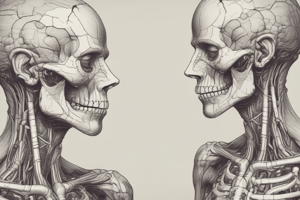Podcast
Questions and Answers
What is the primary function of the skin known as 'barrier function'?
What is the primary function of the skin known as 'barrier function'?
- Serving as the first line of defense against physical trauma
- Allowing necessary nutrients to pass through
- Preventing excessive heat loss or gain
- Keeping harmful pathogens out (correct)
Which process is responsible for reducing skin temperature by taking energy away from the body?
Which process is responsible for reducing skin temperature by taking energy away from the body?
- Convection
- Evaporation (correct)
- Radiation
- Vasoconstriction
What is the function of sweat glands in the context of thermoregulation?
What is the function of sweat glands in the context of thermoregulation?
- Preventing bacterial infections
- Regulating blood flow to the skin
- Enhancing sensory input
- Facilitating evaporative cooling (correct)
Which skin function involves transmitting sensations like touch, pressure, and pain to the brain?
Which skin function involves transmitting sensations like touch, pressure, and pain to the brain?
How does the skin contribute to thermoregulation through convection?
How does the skin contribute to thermoregulation through convection?
Which type of sweat gland is primarily responsible for thermoregulation?
Which type of sweat gland is primarily responsible for thermoregulation?
What are the main components of sweat produced by eccrine glands?
What are the main components of sweat produced by eccrine glands?
In which areas of the body are apocrine glands predominantly found?
In which areas of the body are apocrine glands predominantly found?
Apart from sweat glands, what other structures are found in human skin?
Apart from sweat glands, what other structures are found in human skin?
Which type of gland does not significantly contribute to the cooling processes of the body?
Which type of gland does not significantly contribute to the cooling processes of the body?
Flashcards are hidden until you start studying
Study Notes
Excretion Through Skin: Understanding Sweat Glands and Body Temperature Regulation
Skin isn't merely our protective barrier; it also plays an essential role in maintaining our bodily balance through excretion via specialized structures such as sweat glands. In this exploration of excretion through the skin, we will delve into its components — sweat glands, skin functions, and their combined role in regulating body temperature.
Sweat Glands: Nature's Cooling System
There are two main types of sweat glands found within our skin: eccrine and apocrine glands:
- Eccrine glands – Widely distributed across the entire surface area of human skin, these glands primarily contribute to thermoregulation. They produce sweat which is almost entirely composed of water, salts, urea, and lactate, all of which help to cool the body when evaporated from the skin's surface.
- Apocrine glands – Found mainly in hairy areas like armpits and genitalia, they release odorless fluid during periods of stress and excitement, with some bacteria present breaking down the secretions resulting in body odors. These glands do not significantly contribute to cooling processes.
Skin Functions: A Complex Organ
Our skin is more than just a barrier against external elements; it contains many vital organs, including blood vessels, nerve endings, and immunological cells. Some of the primary functions of the skin include:
- Insulation: Our skin provides insulation for the body, protecting us from fluctuations in environmental temperatures while preventing excessive heat loss or gain.
- Barrier function: It effectively acts as a permeability barrier, keeping harmful pathogens out while allowing necessary nutrients and waste products to pass.
- Protection: Constantly exposed to physical trauma, chemicals, UV radiation, and pathogenic microorganisms, the skin serves as the first line of defense for our bodies against external threats.
- Sensory input: Nerve fibers embedded throughout the dermis transmit sensations such as touch, pressure, and pain to the brain.
Regulation of Body Temperature: Working Together
The maintenance of core body temperature is crucial for sustaining life. We rely heavily on homeostatic mechanisms that ensure optimal physiologic functioning under different conditions. Among several strategies employed, skin plays an integral role in thermoregulation:
- Radiation: Heat escapes the body directly, emitted as infra-red light, releasing excess warmth into the environment. As ambient temperatures decrease, skin radiates less heat.
- Convection: Blood flow increases to the skin when overheating occurs, promoting rapid dissipation of heat from the body's surface via air currents. Similarly, vasoconstriction reduces blood flow to the outer layers of skin when cold prevails, conserving heat.
- Evaporation: When perspiration comes in contact with warm or humid air, it turns into vapor, taking energy away from your body, thus lowering skin temperature. This process is known as evaporative cooling.
In summary, the intricate interplay between various skin functions along with sweating activities facilitated by sweat glands enables effective thermoregulatory responses that maintain stable internal environments despite varying external factors.
Studying That Suits You
Use AI to generate personalized quizzes and flashcards to suit your learning preferences.




